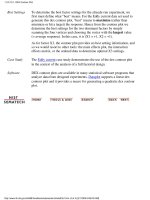Engineering Statistics Handbook Episode 2 Part 5 pptx
Bạn đang xem bản rút gọn của tài liệu. Xem và tải ngay bản đầy đủ của tài liệu tại đây (148.69 KB, 20 trang )
The formula for the cumulative hazard function of the Gumbel
distribution (maximum) is
The following is the plot of the Gumbel cumulative hazard function for
the maximum case.
1.3.6.6.16. Extreme Value Type I Distribution
(8 of 12) [5/1/2006 9:58:22 AM]
Survival
Function
The formula for the survival function of the Gumbel distribution
(minimum) is
The following is the plot of the Gumbel survival function for the
minimum case.
The formula for the survival function of the Gumbel distribution
(maximum) is
The following is the plot of the Gumbel survival function for the
maximum case.
1.3.6.6.16. Extreme Value Type I Distribution
(9 of 12) [5/1/2006 9:58:22 AM]
Inverse
Survival
Function
The formula for the inverse survival function of the Gumbel distribution
(minimum) is
The following is the plot of the Gumbel inverse survival function for the
minimum case.
1.3.6.6.16. Extreme Value Type I Distribution
(10 of 12) [5/1/2006 9:58:22 AM]
The formula for the inverse survival function of the Gumbel distribution
(maximum) is
The following is the plot of the Gumbel inverse survival function for the
maximum case.
Common
Statistics
The formulas below are for the maximum order statistic case.
Mean
The constant 0.5772 is Euler's number.
Median
Mode
Range Negative infinity to positive infinity.
Standard Deviation
Skewness 1.13955
Kurtosis 5.4
Coefficient of
Variation
1.3.6.6.16. Extreme Value Type I Distribution
(11 of 12) [5/1/2006 9:58:22 AM]
Parameter
Estimation
The method of moments estimators of the Gumbel (maximum)
distribution are
where and s are the sample mean and standard deviation,
respectively.
The equations for the maximum likelihood estimation of the shape and
scale parameters are discussed in Chapter 15 of Evans, Hastings, and
Peacock and Chapter 22 of Johnson, Kotz, and Balakrishnan. These
equations need to be solved numerically and this is typically
accomplished by using statistical software packages.
Software
Some general purpose statistical software programs, including Dataplot,
support at least some of the probability functions for the extreme value
type I distribution.
1.3.6.6.16. Extreme Value Type I Distribution
(12 of 12) [5/1/2006 9:58:22 AM]
Cumulative
Distribution
Function
The formula for the cumulative distribution function of the beta distribution is also
called the incomplete beta function ratio (commonly denoted by I
x
) and is defined as
where B is the beta function defined above.
The following is the plot of the beta cumulative distribution function with the same
values of the shape parameters as the pdf plots above.
1.3.6.6.17. Beta Distribution
(2 of 4) [5/1/2006 9:58:23 AM]
Percent
Point
Function
The formula for the percent point function of the beta distribution does not exist in a
simple closed form. It is computed numerically.
The following is the plot of the beta percent point function with the same values of the
shape parameters as the pdf plots above.
Other
Probability
Functions
Since the beta distribution is not typically used for reliability applications, we omit the
formulas and plots for the hazard, cumulative hazard, survival, and inverse survival
probability functions.
Common
Statistics
The formulas below are for the case where the lower limit is zero and the upper limit is
one.
Mean
Mode
Range 0 to 1
Standard Deviation
Coefficient of Variation
Skewness
1.3.6.6.17. Beta Distribution
(3 of 4) [5/1/2006 9:58:23 AM]
Parameter
Estimation
First consider the case where a and b are assumed to be known. For this case, the
method of moments estimates are
where is the sample mean and s
2
is the sample variance. If a and b are not 0 and 1,
respectively, then replace
with and s
2
with in the above
equations.
For the case when a and b are known, the maximum likelihood estimates can be
obtained by solving the following set of equations
The maximum likelihood equations for the case when a and b are not known are given
in pages 221-235 of Volume II of Johnson, Kotz, and Balakrishan.
Software
Most general purpose statistical software programs, including Dataplot, support at
least some of the probability functions for the beta distribution.
1.3.6.6.17. Beta Distribution
(4 of 4) [5/1/2006 9:58:23 AM]
Cumulative
Distribution
Function
The formula for the binomial cumulative probability function is
The following is the plot of the binomial cumulative distribution function with
the same values of p as the pdf plots above.
1.3.6.6.18. Binomial Distribution
(2 of 4) [5/1/2006 9:58:24 AM]
Percent
Point
Function
The binomial percent point function does not exist in simple closed form. It is
computed numerically. Note that because this is a discrete distribution that is
only defined for integer values of x, the percent point function is not smooth in
the way the percent point function typically is for a continuous distribution.
The following is the plot of the binomial percent point function with the same
values of p as the pdf plots above.
Common
Statistics
Mean
Mode
Range 0 to N
Standard Deviation
Coefficient of
Variation
Skewness
Kurtosis
Comments The binomial distribution is probably the most commonly used discrete
distribution.
1.3.6.6.18. Binomial Distribution
(3 of 4) [5/1/2006 9:58:24 AM]
Parameter
Estimation
The maximum likelihood estimator of p (n is fixed) is
Software Most general purpose statistical software programs, including Dataplot, support
at least some of the probability functions for the binomial distribution.
1.3.6.6.18. Binomial Distribution
(4 of 4) [5/1/2006 9:58:24 AM]
Cumulative
Distribution
Function
The formula for the Poisson cumulative probability function is
The following is the plot of the Poisson cumulative distribution function
with the same values of
as the pdf plots above.
Percent
Point
Function
The Poisson percent point function does not exist in simple closed form.
It is computed numerically. Note that because this is a discrete
distribution that is only defined for integer values of x, the percent point
function is not smooth in the way the percent point function typically is
for a continuous distribution.
The following is the plot of the Poisson percent point function with the
same values of
as the pdf plots above.
1.3.6.6.19. Poisson Distribution
(2 of 4) [5/1/2006 9:58:24 AM]
Common
Statistics
Mean
Mode
For non-integer
, it is the largest integer less
than . For integer , x = and x = - 1 are
both the mode.
Range 0 to positive infinity
Standard Deviation
Coefficient of
Variation
Skewness
Kurtosis
Parameter
Estimation
The maximum likelihood estimator of
is
where is the sample mean.
Software
Most general purpose statistical software programs, including Dataplot,
support at least some of the probability functions for the Poisson
distribution.
1.3.6.6.19. Poisson Distribution
(3 of 4) [5/1/2006 9:58:24 AM]
1.3.6.6.19. Poisson Distribution
(4 of 4) [5/1/2006 9:58:24 AM]
1. Exploratory Data Analysis
1.3. EDA Techniques
1.3.6. Probability Distributions
1.3.6.7. Tables for Probability Distributions
1.3.6.7.1.Cumulative Distribution Function
of the Standard Normal
Distribution
How to Use
This Table
The table below contains the area under the standard normal curve from
0 to z. This can be used to compute the cumulative distribution function
values for the standard normal distribution.
The table utilizes the symmetry of the normal distribution, so what in
fact is given is
where a is the value of interest. This is demonstrated in the graph below
for a = 0.5. The shaded area of the curve represents the probability that x
is between 0 and a.
1.3.6.7.1. Cumulative Distribution Function of the Standard Normal Distribution
(1 of 4) [5/1/2006 9:58:25 AM]
This can be clarified by a few simple examples.
What is the probability that x is less than or equal to 1.53? Look
for 1.5 in the X column, go right to the 0.03 column to find the
value 0.43699. Now add 0.5 (for the probability less than zero) to
obtain the final result of 0.93699.
1.
What is the probability that x is less than or equal to -1.53? For
negative values, use the relationship
From the first example, this gives 1 - 0.93699 = 0.06301.
2.
What is the probability that x is between -1 and 0.5? Look up the
values for 0.5 (0.5 + 0.19146 = 0.69146) and -1 (1 - (0.5 +
0.34134) = 0.15866). Then subtract the results (0.69146 -
0.15866) to obtain the result 0.5328.
3.
To use this table with a non-standard normal distribution (either the
location parameter is not 0 or the scale parameter is not 1), standardize
your value by subtracting the mean and dividing the result by the
standard deviation. Then look up the value for this standardized value.
A few particularly important numbers derived from the table below,
specifically numbers that are commonly used in significance tests, are
summarized in the following table:
p 0.001 0.005 0.010 0.025 0.050 0.100
Z
p
-3.090 -2.576 -2.326 -1.960 -1.645 -1.282
p 0.999 0.995 0.990 0.975 0.950 0.900
Z
p
+3.090 +2.576 +2.326 +1.960 +1.645 +1.282
These are critical values for the normal distribution.
Area under the Normal Curve from
0 to X
X 0.00 0.01 0.02 0.03 0.04 0.05 0.06
0.07 0.08 0.09
0.0 0.00000 0.00399 0.00798 0.01197 0.01595 0.01994
0.02392 0.02790 0.03188 0.03586
0.1 0.03983 0.04380 0.04776 0.05172 0.05567 0.05962
0.06356 0.06749 0.07142 0.07535
1.3.6.7.1. Cumulative Distribution Function of the Standard Normal Distribution
(2 of 4) [5/1/2006 9:58:25 AM]
0.2 0.07926 0.08317 0.08706 0.09095 0.09483 0.09871
0.10257 0.10642 0.11026 0.11409
0.3 0.11791 0.12172 0.12552 0.12930 0.13307 0.13683
0.14058 0.14431 0.14803 0.15173
0.4 0.15542 0.15910 0.16276 0.16640 0.17003 0.17364
0.17724 0.18082 0.18439 0.18793
0.5 0.19146 0.19497 0.19847 0.20194 0.20540 0.20884
0.21226 0.21566 0.21904 0.22240
0.6 0.22575 0.22907 0.23237 0.23565 0.23891 0.24215
0.24537 0.24857 0.25175 0.25490
0.7 0.25804 0.26115 0.26424 0.26730 0.27035 0.27337
0.27637 0.27935 0.28230 0.28524
0.8 0.28814 0.29103 0.29389 0.29673 0.29955 0.30234
0.30511 0.30785 0.31057 0.31327
0.9 0.31594 0.31859 0.32121 0.32381 0.32639 0.32894
0.33147 0.33398 0.33646 0.33891
1.0 0.34134 0.34375 0.34614 0.34849 0.35083 0.35314
0.35543 0.35769 0.35993 0.36214
1.1 0.36433 0.36650 0.36864 0.37076 0.37286 0.37493
0.37698 0.37900 0.38100 0.38298
1.2 0.38493 0.38686 0.38877 0.39065 0.39251 0.39435
0.39617 0.39796 0.39973 0.40147
1.3 0.40320 0.40490 0.40658 0.40824 0.40988 0.41149
0.41308 0.41466 0.41621 0.41774
1.4 0.41924 0.42073 0.42220 0.42364 0.42507 0.42647
0.42785 0.42922 0.43056 0.43189
1.5 0.43319 0.43448 0.43574 0.43699 0.43822 0.43943
0.44062 0.44179 0.44295 0.44408
1.6 0.44520 0.44630 0.44738 0.44845 0.44950 0.45053
0.45154 0.45254 0.45352 0.45449
1.7 0.45543 0.45637 0.45728 0.45818 0.45907 0.45994
0.46080 0.46164 0.46246 0.46327
1.8 0.46407 0.46485 0.46562 0.46638 0.46712 0.46784
0.46856 0.46926 0.46995 0.47062
1.9 0.47128 0.47193 0.47257 0.47320 0.47381 0.47441
0.47500 0.47558 0.47615 0.47670
2.0 0.47725 0.47778 0.47831 0.47882 0.47932 0.47982
0.48030 0.48077 0.48124 0.48169
2.1 0.48214 0.48257 0.48300 0.48341 0.48382 0.48422
0.48461 0.48500 0.48537 0.48574
2.2 0.48610 0.48645 0.48679 0.48713 0.48745 0.48778
0.48809 0.48840 0.48870 0.48899
2.3 0.48928 0.48956 0.48983 0.49010 0.49036 0.49061
0.49086 0.49111 0.49134 0.49158
2.4 0.49180 0.49202 0.49224 0.49245 0.49266 0.49286
0.49305 0.49324 0.49343 0.49361
1.3.6.7.1. Cumulative Distribution Function of the Standard Normal Distribution
(3 of 4) [5/1/2006 9:58:25 AM]
2.5 0.49379 0.49396 0.49413 0.49430 0.49446 0.49461
0.49477 0.49492 0.49506 0.49520
2.6 0.49534 0.49547 0.49560 0.49573 0.49585 0.49598
0.49609 0.49621 0.49632 0.49643
2.7 0.49653 0.49664 0.49674 0.49683 0.49693 0.49702
0.49711 0.49720 0.49728 0.49736
2.8 0.49744 0.49752 0.49760 0.49767 0.49774 0.49781
0.49788 0.49795 0.49801 0.49807
2.9 0.49813 0.49819 0.49825 0.49831 0.49836 0.49841
0.49846 0.49851 0.49856 0.49861
3.0 0.49865 0.49869 0.49874 0.49878 0.49882 0.49886
0.49889 0.49893 0.49896 0.49900
3.1 0.49903 0.49906 0.49910 0.49913 0.49916 0.49918
0.49921 0.49924 0.49926 0.49929
3.2 0.49931 0.49934 0.49936 0.49938 0.49940 0.49942
0.49944 0.49946 0.49948 0.49950
3.3 0.49952 0.49953 0.49955 0.49957 0.49958 0.49960
0.49961 0.49962 0.49964 0.49965
3.4 0.49966 0.49968 0.49969 0.49970 0.49971 0.49972
0.49973 0.49974 0.49975 0.49976
3.5 0.49977 0.49978 0.49978 0.49979 0.49980 0.49981
0.49981 0.49982 0.49983 0.49983
3.6 0.49984 0.49985 0.49985 0.49986 0.49986 0.49987
0.49987 0.49988 0.49988 0.49989
3.7 0.49989 0.49990 0.49990 0.49990 0.49991 0.49991
0.49992 0.49992 0.49992 0.49992
3.8 0.49993 0.49993 0.49993 0.49994 0.49994 0.49994
0.49994 0.49995 0.49995 0.49995
3.9 0.49995 0.49995 0.49996 0.49996 0.49996 0.49996
0.49996 0.49996 0.49997 0.49997
4.0 0.49997 0.49997 0.49997 0.49997 0.49997 0.49997
0.49998 0.49998 0.49998 0.49998
1.3.6.7.1. Cumulative Distribution Function of the Standard Normal Distribution
(4 of 4) [5/1/2006 9:58:25 AM]
Given a specified value for :
For a two-sided test, find the column corresponding to
/2 and
reject the null hypothesis if the absolute value of the test statistic is
greater than the value of
in the table below.
1.
For an upper one-sided test, find the column corresponding to
and reject the null hypothesis if the test statistic is greater than the
tabled value.
2.
For an lower one-sided test, find the column corresponding to
and reject the null hypothesis if the test statistic is less than the
negative of the tabled value.
3.
Upper critical values of Student's t distribution with degrees of
freedom
Probability of exceeding the
critical value
0.10 0.05 0.025 0.01
0.005 0.001
1. 3.078 6.314 12.706 31.821
63.657 318.313
2. 1.886 2.920 4.303 6.965
9.925 22.327
3. 1.638 2.353 3.182 4.541
5.841 10.215
4. 1.533 2.132 2.776 3.747
4.604 7.173
5. 1.476 2.015 2.571 3.365
4.032 5.893
6. 1.440 1.943 2.447 3.143
3.707 5.208
1.3.6.7.2. Upper Critical Values of the Student's-t Distribution
(2 of 8) [5/1/2006 9:58:25 AM]









